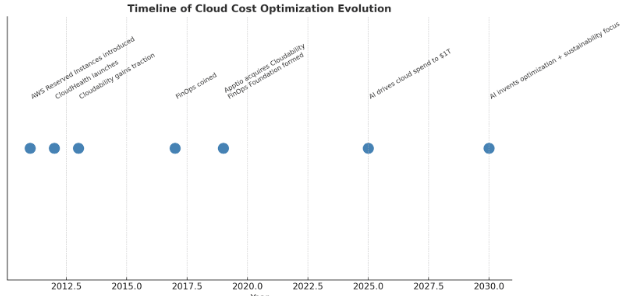The Evolution of Cost Optimization: From AWS's Sneaky Discounts to AI's Wild Ride
Posted
Hey there, fellow cloud nerds. As a veteran of the cloud cost wars -I've spent much of my career helping customers wrestling rogue EC2 instances into submission, negotiating with customers on large cloud computing commitments, and preaching the gospel of FinOps to skeptical execs who think "cloud" is just a fancy word for "free servers in the sky." If you've ever stared at a bill that could fund a small nation's space program and wondered, "How did we get here?", buckle up. Today, we're tracing the wild, windy road of cloud cost optimization. It's a tale of innovation, desperation, and a dash of corporate Darwinism. And yeah, I'll throw in some laughs because, let's face it, nothing says "fun" like spreadsheets full of spend leakage.
Picture this: It's the early 2010s. The cloud is the shiny new toy everyone's fighting over. AWS, the juggernaut of digital real estate, drops a bombshell in February 2011 with Reserved Instances (RIs). Suddenly, you're not just renting compute power by the hour like a millennial on Uber—you're locking in deals for a year or three, slashing costs by up to 75% off On-Demand pricing. It was genius, really. AWS execs were like, "Hey, commit to us long-term, and we'll make it hurt less." As one early adopter put it, RIs turned the cloud from a black hole of expenses into something resembling a predictable utility bill. But here's the kicker: Most folks treated RIs like a casino bet. Buy 'em wrong, and you're stuck with unused capacity, wondering why your "savings" feel like paying for a gym membership you never use. Classic human error, served with a side of FOMO.

Fast-forward a couple years, and the plot thickens. By 2013, cloud bills are ballooning faster than revenue expectations. Enter the third-party saviors: Tools like Cloudability (launched in 2011 as a scrappy Portland startup) and CloudHealth (hitting the scene around 2012, later scooped up by VMware). These weren't just dashboards; they were full-blown rebellions against AWS's opaque billing empire. Cloudability's founders saw the chaos—spreadsheets the size of War and Peace, teams guessing at optimizations—and said, "Nah, we're building an empire on visibility." CloudHealth piled on with multi-cloud muscle, spotting idle resources like a hawk. Before you knew it, these platforms weren't just tools; they birthed entire companies. Apptio snapped up Cloudability in 2019 for a cool chunk of change, turning cost management into a billion-dollar industry. These third-parties exposed the dirty secret: Cloud providers love your waste. It's their business model. But hey, at least now there are weapons.
And then, because the universe loves a good plot twist, along comes FinOps. If RIs were the spark and third-party tools the gasoline, FinOps is the bonfire. Coined around 2017 by trailblazers like J.R. Storment (author of Cloud FinOps and basically the Yoda of this space), he flipped the script from "IT vs. Finance" to "Hey, let's all hug it out and use data." Storment nails it: "FinOps is the practice of bringing financial accountability to the variable spend model of the cloud, enabling distributed teams to make business trade-offs between speed, cost, and quality." By 2019, the FinOps Foundation (under the Linux Foundation umbrella) was official, pumping out certifications like candy at a parade. Suddenly, companies aren't just hiring "cloud engineers"—they're building whole tribes of Certified FinOps Practitioners, Pros, and even Executives. It's collaborative chaos: Engineers tag resources, finance forecasts like weather wizards, and product leads decide if that shiny new ML model is worth the electric bill. Gartner calls it a "business leadership imperative," but let's be real - it's therapy for digital native teams. As Storment quipped in his book, "Finance teams struggle to understand and keep up with what teams are spending and to properly allocate cloud investments." Preach, brother. Today, over 70% of enterprises have dedicated FinOps functions, turning cost optimization from a side hustle into a C-suite obsession.
But enough back-patting—where's this circus headed? Strap in, because the future is equal parts exhilarating and terrifying, like handing the keys to a Ferrari to a caffeinated toddler. First off: AI. Oh boy, AI. It’s not just booming—it’s a full-blown supernova, devouring cloud budgets faster than Taylor Swift tickets disappear for the Eras tour. By 2025, end-user cloud spending is expected to eclipse $1 trillion, with AI/ML workloads claiming a considerable slice - think 30-50% of total compute in some orgs. The tech promising efficiency is a joke. Training a single large language model can torch $100K in GPU hours faster than you can say "vibe coding." But here's the provocative bit: AI isn't the villain; it's the reluctant hero. Tools like CloudZero's AI-powered Advisor are already flipping the script, using predictive analytics to forecast spend with eerie accuracy. Erik Peterson, CloudZero's CTO, puts it bluntly: "CloudZero Intelligence marks a major leap forward... making cost efficiency more accessible to everyone—because the cloud should drive innovation, not headaches."
My lofty predictions? By 2030, AI won't just optimize costs—it'll invent them. Imagine swapping providers mid-flight for the best deal, or generative AI drafting FinOps policies that evolve with your business (and roast your wasteful devs in the process). Sustainability crashes the party too—FinOps teams will tag-team with green initiatives, optimizing not just dollars but carbon footprints. Wild? Sure. But as the FinOps Foundation's community echoes, "Organizations that accurately predict their cloud spend are in a better position to... let engineers experiment and innovate." We're heading toward a world where cost optimization isn't a chore—it's required.
So, what's your move? If you're still treating cloud bills like abstract art, wake up. Dive into FinOps, arm yourself with AI smarts, and remember: In the cloud, fortune favors the optimized. Get in touch if you are looking for better ways to slay the billing dragon? Let's swap war stories.
Tyler Beim - Follow on LinkedIn for more rants disguised as wisdom.